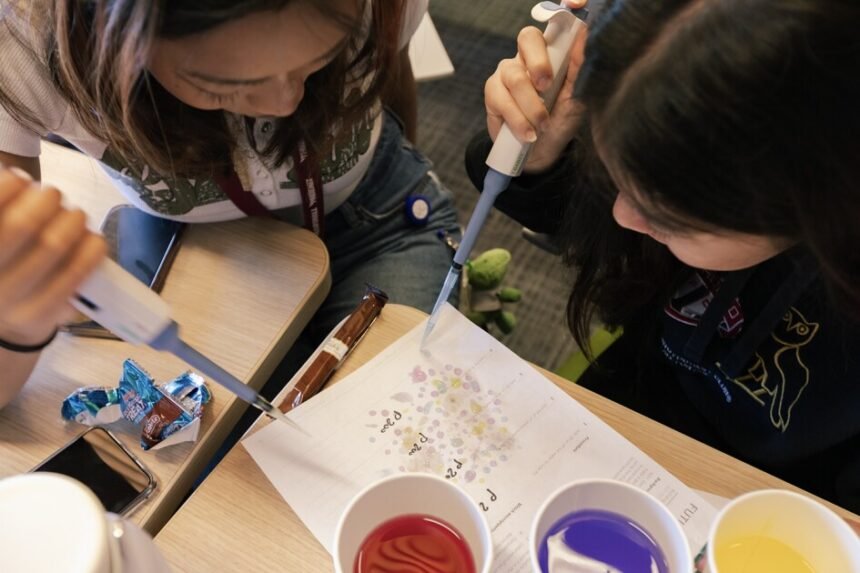Students in Kristen Gonsoir’s classroom at Groton Area High School in Groton, S.D., spend a lot of time solving equations together.
Early this school year, they passed almost an entire period working in groups on a particularly tricky word problem: If someone has a garden 10 feet by 10 feet, divided into three plots, how many kilograms of fertilizer would they need for each plot, applying fertilizer at a concentration of 1,000 pounds per acre?
Gonsoir walked around from group to group, listening in on students’ conversations and reviewing their calculations to see where she had to shore up misunderstandings.
But despite all of the math going on in her room, Gonsoir isn’t a math teacher. She teaches science. The word problem was a way for them to practice the skills they’d need to make conversions between different components involved in chemical reactions.
“Chemistry is, as the kids say, just another math class,” said Gonsoir.
Math has always been a core part of science, especially in high school chemistry and physics—so much so that many studies have found a correlation between students’ high school math abilities and their performance in college science classes. More recently, the Next Generation Science Standards, first unveiled in 2013, can’t remember when. But it would be good to give a sense of how long they’ve been around. SS emphasized quantitative reasoning and data analysis. The standards have been adopted by 20 states and the District of Columbia.
But some high school teachers say that many of their students come into science classes unprepared to handle the math demands the subject requires of them.
“They’ve kind of forgotten the really, really basic things from algebra,” said Lisa Kern, a chemistry and environmental science teacher at Avon High School outside of Indianapolis.
The gaps in math knowledge that students arrive with in high school may be especially wide now, as multiple studies of student achievement show lagging middle school achievement.
Even so, teachers say, science curricula don’t often build in time or resources to reinforce basic math concepts—and it’s usually logistically difficult to facilitate collaboration between high school math and science departments.
Education Week spoke with science educators for their tips on how to embed math practice into their classrooms and align their math teaching to that of the math teachers in their district. Read on for four ways that educators said they approached these challenges.
1. Model math frequently
Because students come into class with different levels of math skill, Kern, the Indianapolis teacher, explicitly reteaches some concepts from the beginning.
When she introduces the formula for density—density equals mass divided by volume, or d=m/v—she shows students how to cross-multiply. During the course of the unit, she might show a worked example of a problem or two on the board every day.
Dylan Fedell, a science teacher at Palisades High School in Kintersville, Penn., reteaches geometry concepts in his physics classes, when explaining how forces act on moving objects.
“I find myself teaching—I don’t want to say from scratch; I’m not doing any derivations—but I’m explaining right triangles, how we’re labeling them,” he said.
It’s not that students never learned the geometry concepts, but they need a teacher to help them make the connection that the same skills apply in science, too, Fedell said. “It’s just two different mindsets,” he said. “Unless you actively work to bring them together, it’s not going to happen.”
2. Work on students’ conceptual understanding of mathematical relationships
In chemistry, students might memorize a formula for, for example, converting grams to moles—two different measurements of mass.
But if they don’t understand the process the formula represents, they’re likely to use it incorrectly at some point, said Gonsoir, the South Dakota teacher.
To try to build that conceptual understanding, Gonsoir assigns lots of problems that require students to convert quantities—like the gardening problem at the beginning of this year, which asked students to translate kilograms to pounds and feet to acres.
“The thing I start the year with is, ‘I know a lot of you aren’t going to be chemists. No one’s going to walk up to you and say, how many grams are in a molar solution of 5% of sodium chloride?’” said Gonsoir. “But I do say, ‘You’re going to have to solve problems, and chemistry gives you a good base for problem-solving.’”
3. Teach math language
Explicitly teaching math vocabulary in science has helped her students grasp concepts more easily, said Jill Christman, a chemistry teacher at Canyon del Oro High School in Oro Valley, Ariz.
She has worked with science teachers across the department so that the terms educators use to describe, for example, how to make a scale on a graph, are the same in biology classes and chemistry classes.
“It’s really helped our students—it’s actually kind of amazing,” Christman said.
Looking forward, she’d like to work with the math department, too, to see if there are other terms that teachers across subjects could use consistently.
If students aren’t making the connection between some of the formulas they’re using in both math and science, Christman said, “there’s something we’re missing as educators.”
4. Seek out cross-disciplinary professional development
When she asks students to solve problems, Gonsoir often uses techniques that she learned from sitting in on math professional development—something she does frequently.
She groups students and asks them to work on the problems at mounted whiteboards throughout the room, a technique from Building Thinking Classrooms, a book of suggestions for teaching practices in math.
Having students talking in groups, and being able to see their problem-solving approaches clearly, makes it easier to identify when students have misunderstandings and correct them quickly, Gonsoir said.
Christman, in Arizona, regularly checks in with the math department to get a better sense of what skills students already have. “A lot it’s very informal,” she said. “I’ll have conversations like, ‘I’ll be using slope this week in my class—at what point did the students learn slope?’”
Still, it can be hard for teachers to find this kind of collaboration time, or for districts to intentionally schedule it, said Dave Celotto, the director of program design and innovation at the National Math and Science Initiative, a nonprofit professional development provider.
Among the organization’s offerings is “vertical team training”—an option in which math and science teachers across several grade levels learn about skill progressions together.
A PD session might focus on a physical science concept that comes up in 7th grade, for instance, and the prealgebra concepts that students learn in earlier grades that they would need to understand the 7th grade content, Celotto said.
This gets teachers across disciplines into this mindset: “How might we do this better, so that we can support what you’re doing?”







